ChatBI Backend Operation Guide
1. Overview
Before using ChatBI, you need to configure data sources, query topics, topic permissions, etc. in the ChatBI operations management backend. This article introduces detailed backend function configuration.
2. Topic Composition
Before building topics, let's first understand what a topic is. You can refer to the following diagram.

3. Usage Guide
3.1. Prerequisites
Data preparation and permission configuration have been completed in the BI platform. See Data Preparation and Permission Configuration.
3.2. Interface Overview
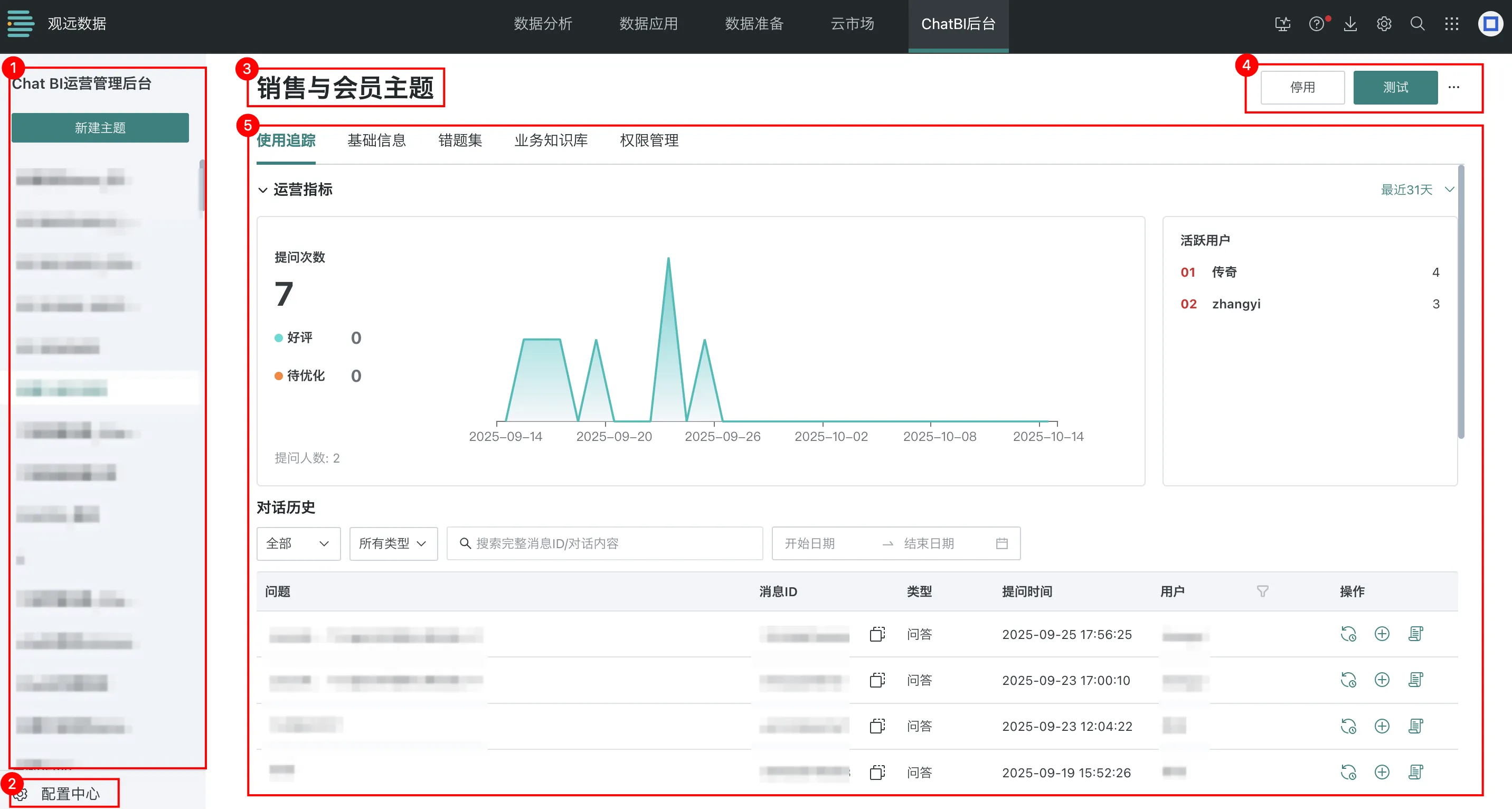
| No. | Description |
|---|---|
| 1 | Topic display area, where you can create new topics and switch topics displayed on the right. |
| 2 | Displays the topic to which the current page belongs, and you can switch in the left area. |
| 3 | Topic function area, where you can perform operations such as enable/disable, test, rename, etc. on the current topic. See Topic Functions. |
| 4 | Operations management backend function configuration area, refer to Function Details. |
3.3. Function Details
3.3.1. New Topic
Chat address is: http://xxx.xxx.xxx.xxx/chatManage (For private deployment customers, please replace the content before /chatManage with your own environment address).
When creating a topic for the first time, it's recommended to create based on a single table. After the single table Q&A accuracy reaches 80%, then expand to other tables for Q&A.
-
In the ChatBI operations management backend, click "New Topic".
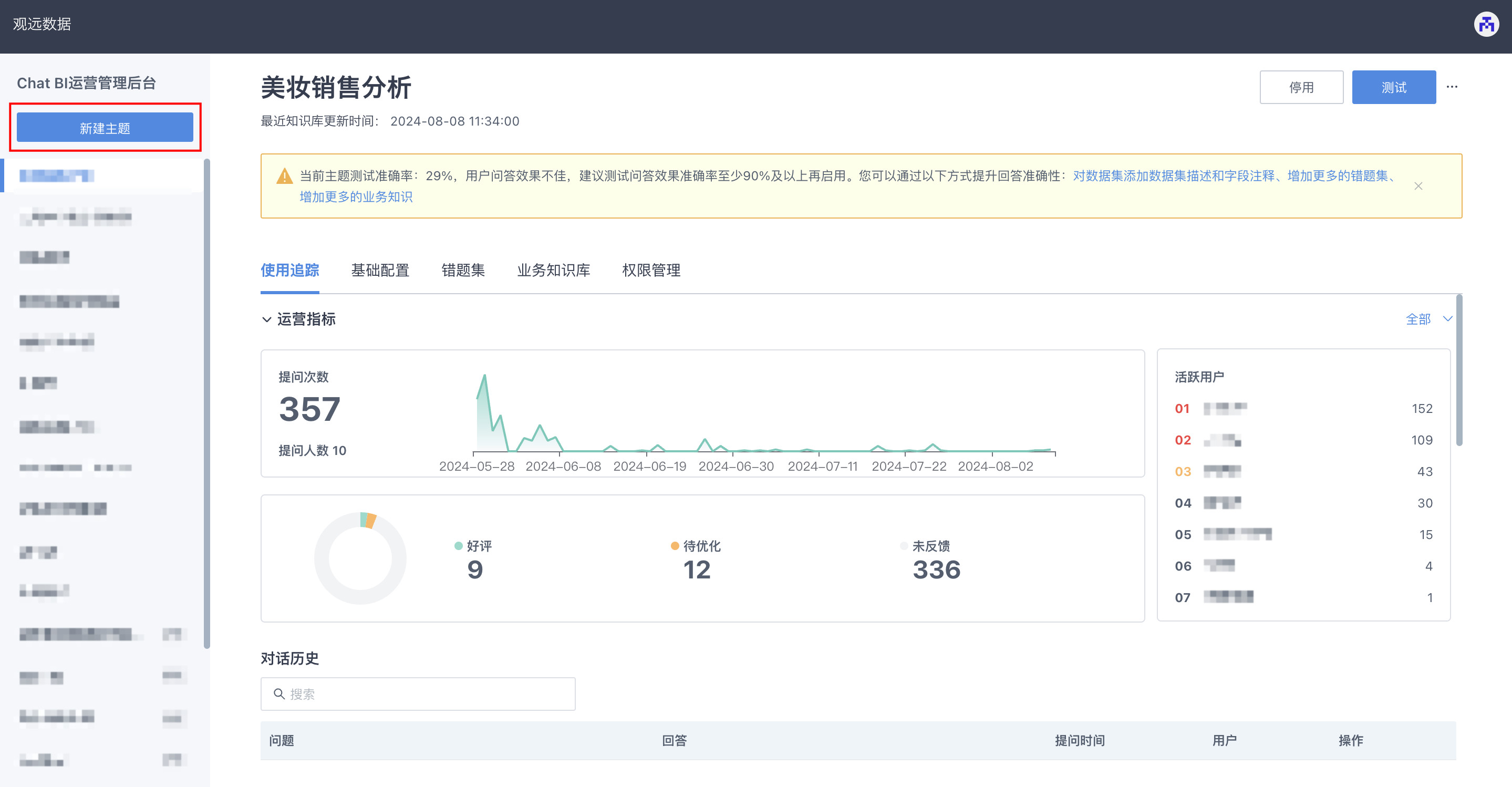
-
Fill in the topic basic information.
If you need to modify basic information later, refer to Basic Configuration.
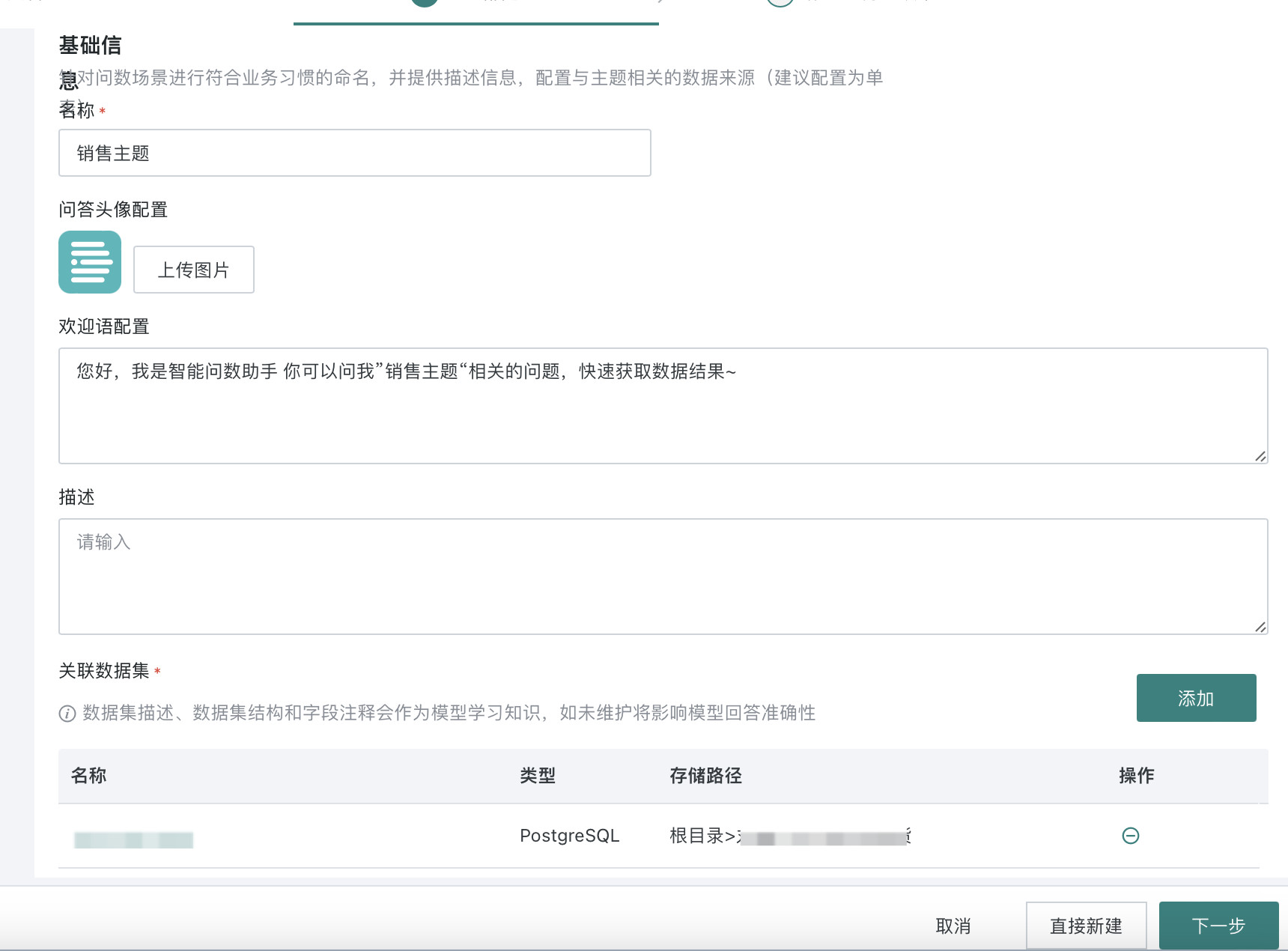
- Topic Name (Required): Briefly summarize the current business topic from a business perspective, which will be used as training knowledge for the large model.
- Q&A Avatar Configuration: Default is GuanYuan logo, users can upload their own images to change the frontend Q&A avatar.
- Welcome Message Configuration (Optional): The first line is the welcome message title by default, and the content starts from the second line.
- Topic Description (Optional): Helps business users understand what business scenarios/problems the current topic can solve, which will be used as training knowledge for the large model.
- Associated Dataset (Required): The data scope for query responses. The current version supports some direct database connections and adding extracted datasets. Dataset descriptions, dataset structures, and field comments will be used as model learning knowledge.
Frontend display effect:
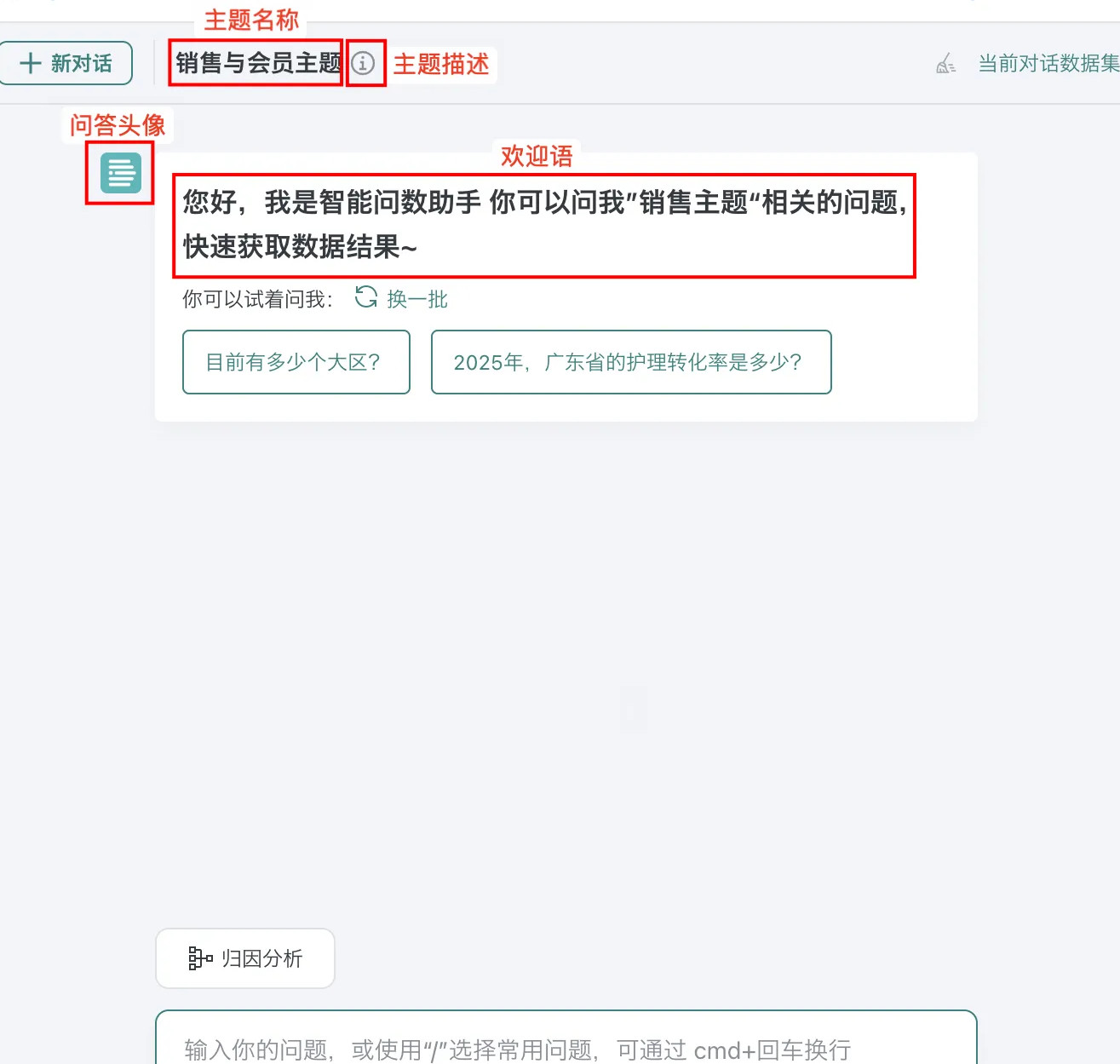
-
Complete topic creation directly/Add business knowledge base.
- If the knowledge base is not ready, you can click "Create Directly" to complete topic creation, and add knowledge in the "Business Knowledge Base" interface later.
For knowledge base related operations, refer to Business Knowledge Base.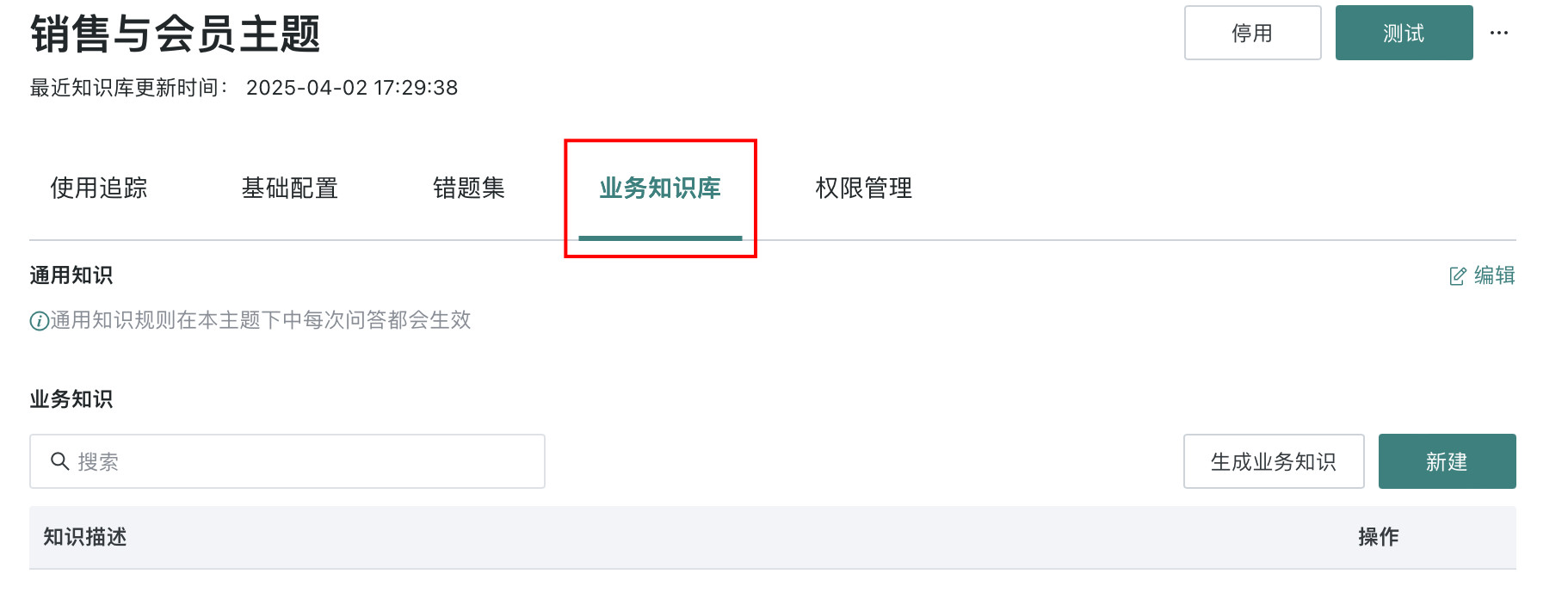
- If the knowledge base is ready, click "Next" to configure the business knowledge set, and click "Complete" after configuration to complete topic creation.
For knowledge base related operations, refer to Business Knowledge Base.
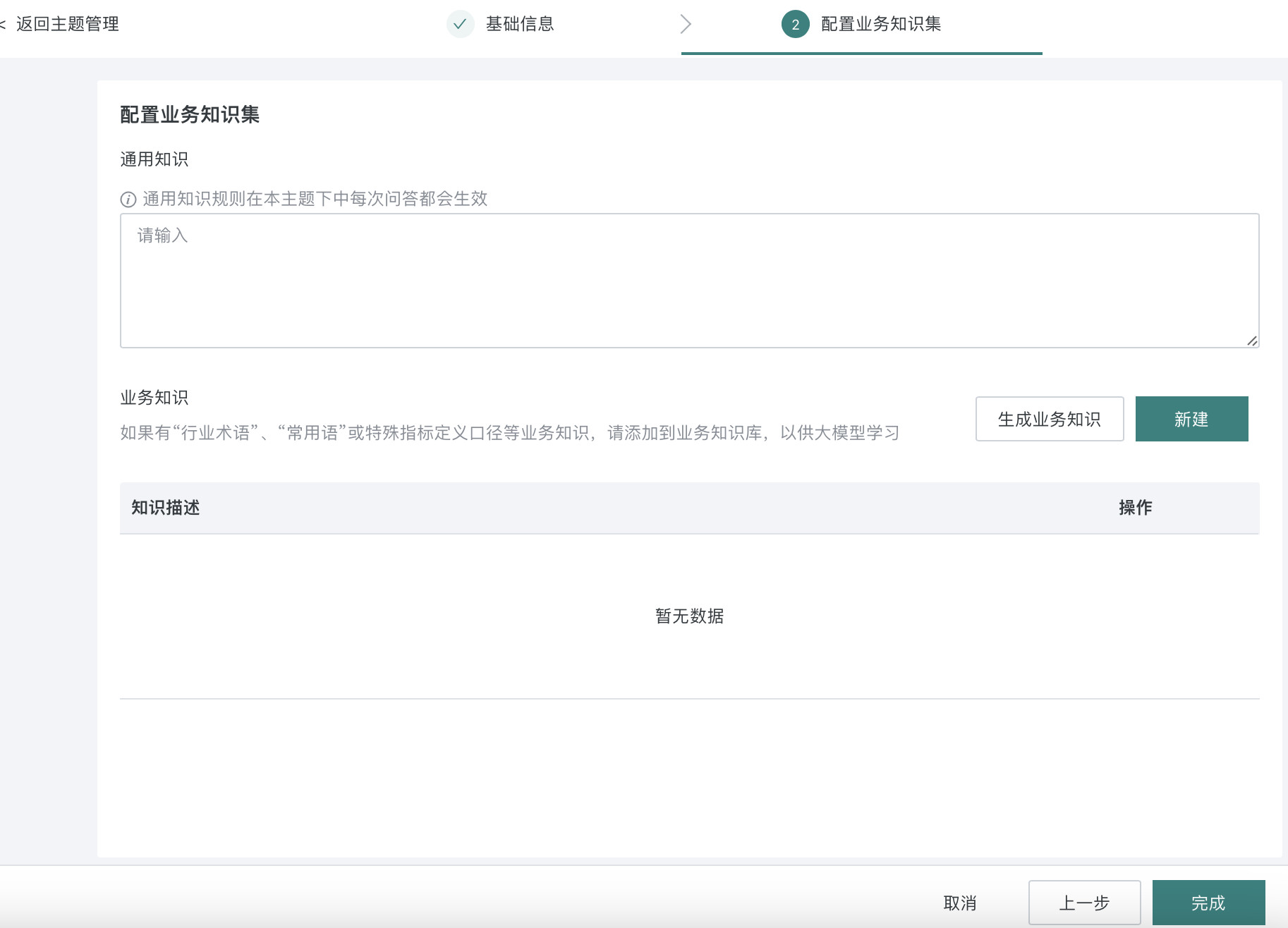
- If the knowledge base is not ready, you can click "Create Directly" to complete topic creation, and add knowledge in the "Business Knowledge Base" interface later.
3.3.2. Usage Tracking
3.3.2.1. Operations Metrics
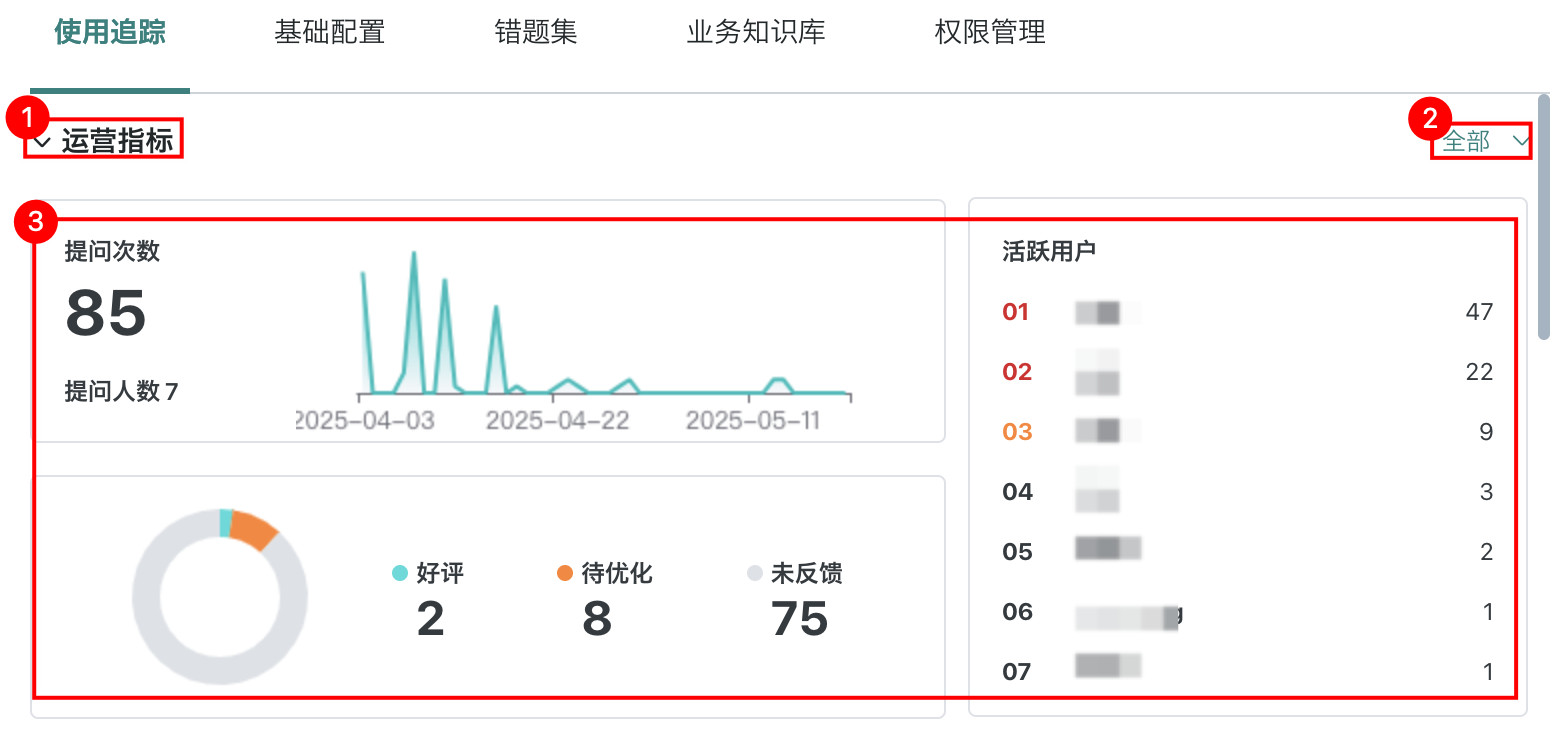
| No. | Description |
|---|---|
| 1 | Toggle whether to display detailed operations metrics data through this button. |
| 2 | Switch to view operations metrics data time range, this filter condition also applies to conversation history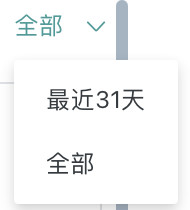 |
| 3 | You can view the number of times the current topic was questioned, number of questioners, active users, and evaluations of query results. Query result evaluations come from frontend feedback during queries. See Feedback. |
3.3.2.2. Conversation History
Each frontend question generates a historical conversation in the backend, supporting filtered viewing.

| No. | Description |
|---|---|
| 1 | You can filter historical conversations based on frontend feedback, complete message ID/conversation content, and time range. |
| 2 | Displays the message ID column, supporting copying message ID to provide to GuanYuan for problem troubleshooting. |
| 3 | Filter historical conversations by type, including Q&A and attribution. |
| 4 | Filter historical conversations by user name. |
| 5 | View historical conversations, where you can view message notifications and operation logs, support adding this problem to the error set, and also support copying SQL and message ID.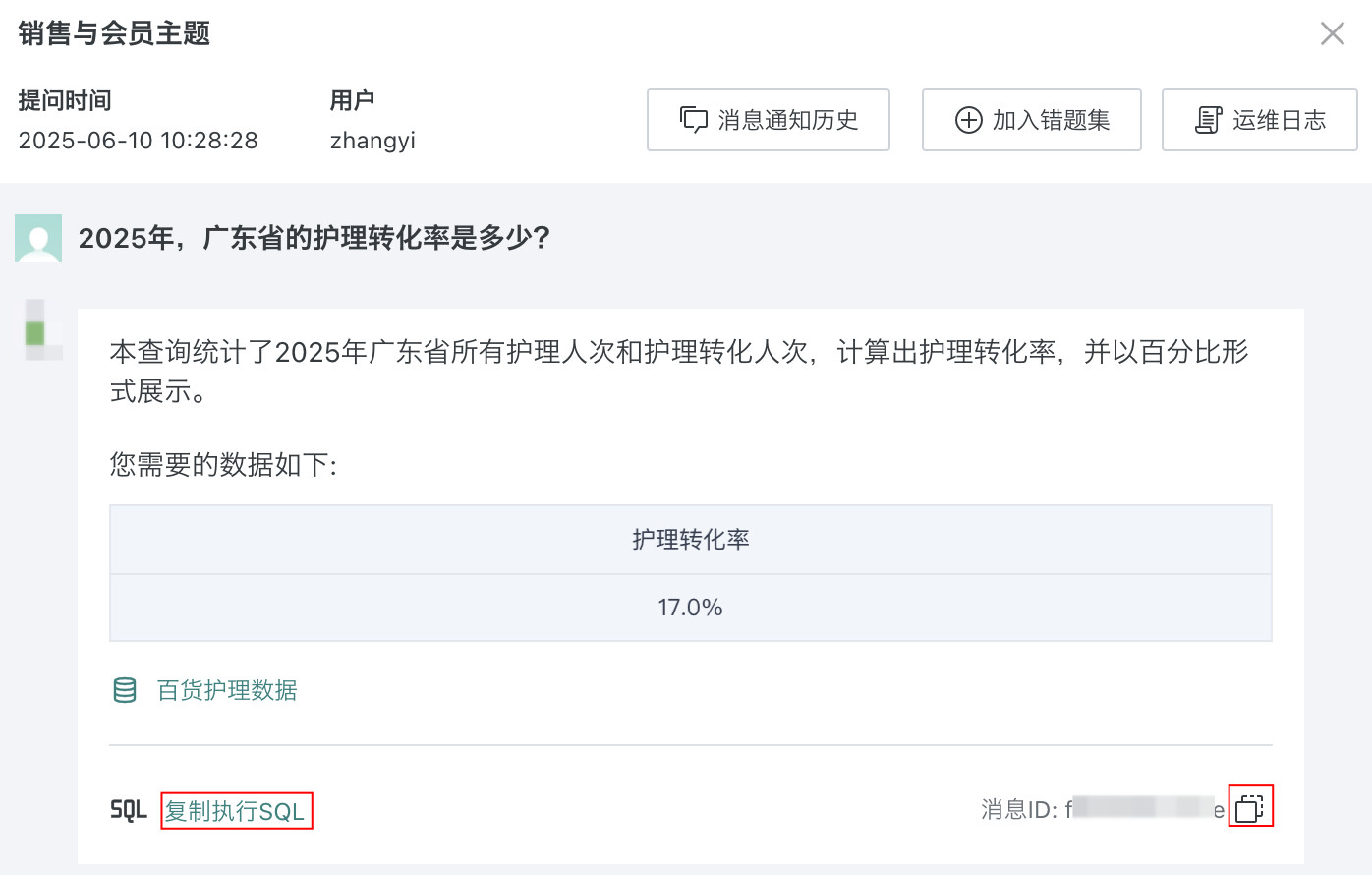 |
| 6 | If the current query returns an incorrect SQL answer, you can click this button, modify the SQL query statement and add this problem to the error set after validation passes. The system will check the current SQL syntax type and provide prompts (extracted dataset syntax type is displayed as Spark). If there are mixed SQL scenarios with different direct connection datasets, an error will be prompted that cross-database queries are currently not supported. 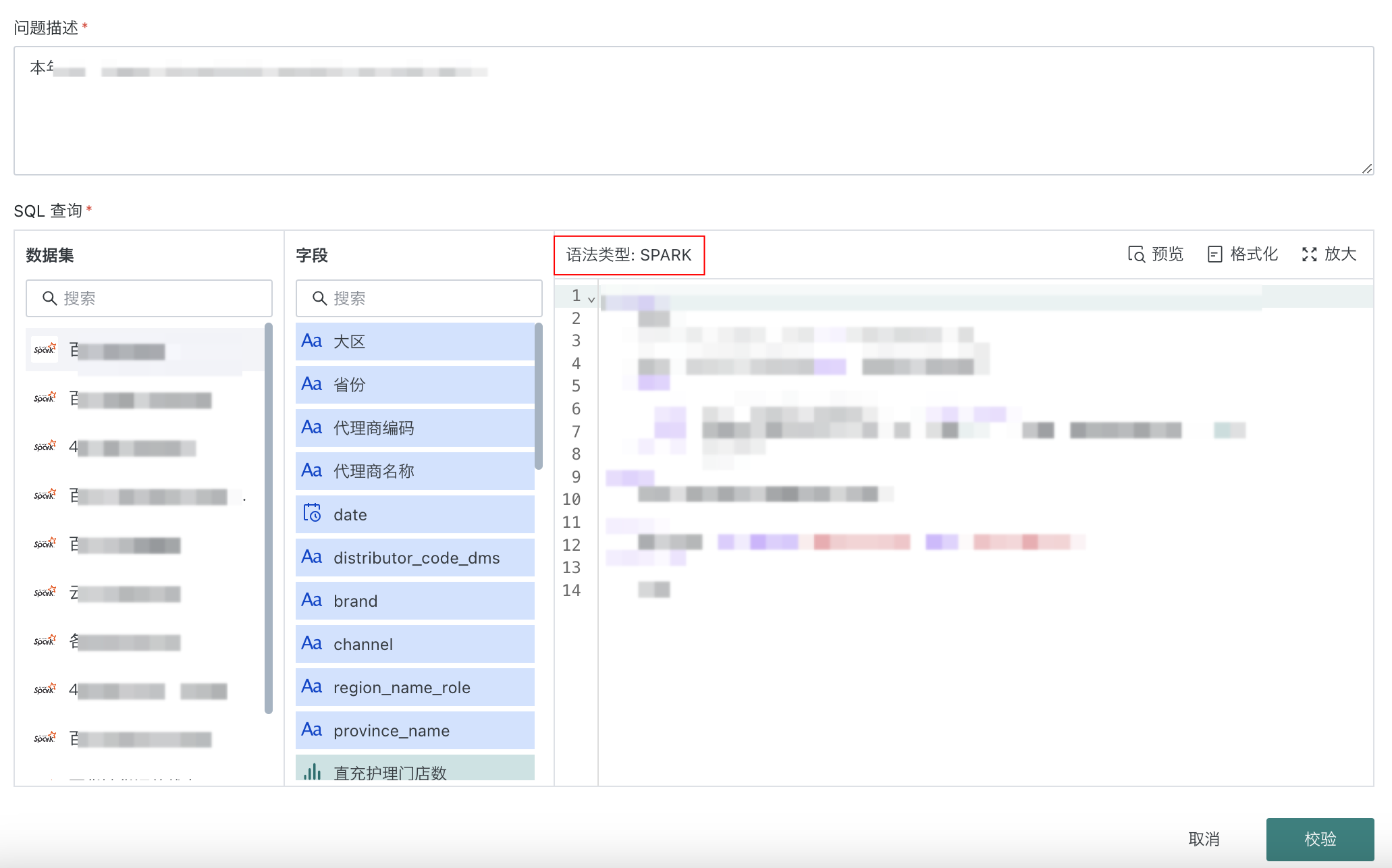 |
| 7 | If frontend query results are unsatisfactory, you can troubleshoot the cause by viewing operation logs. Operation logs include: |
3.3.3. Basic Configuration
3.3.3.1. Basic Information Configuration
Displays the current topic's basic configuration, where you can modify the avatar, welcome message, and topic description.
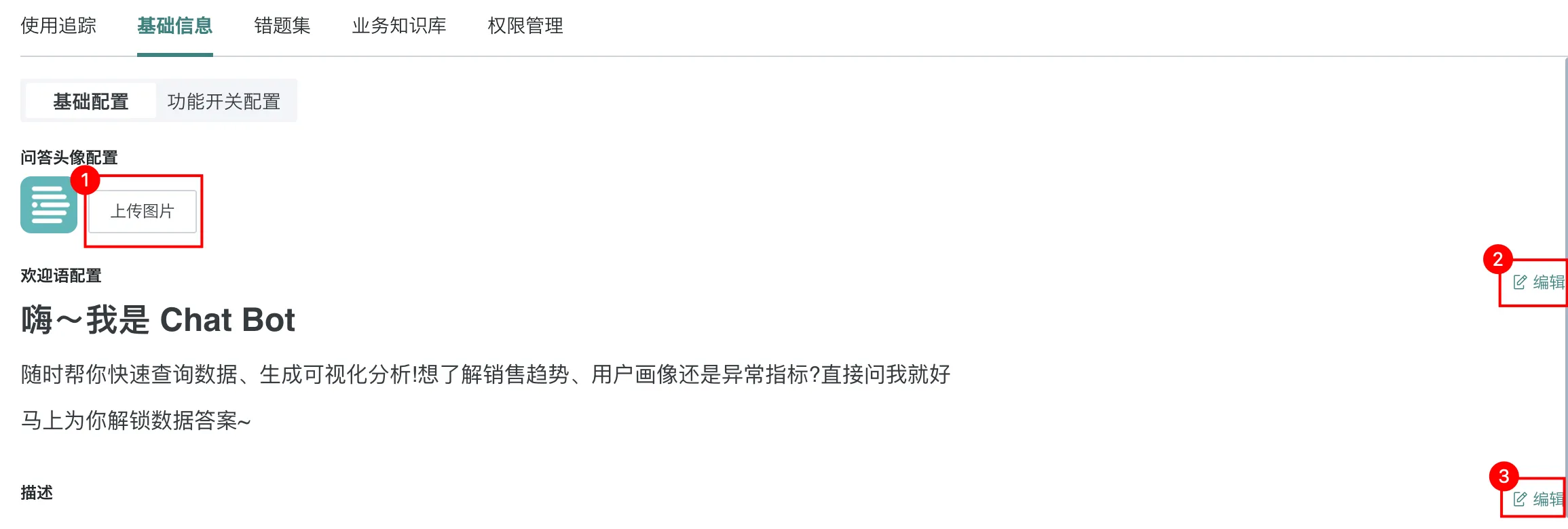
| No. | Description |
|---|---|
| 1 | The Q&A avatar defaults to GuanYuan Data logo, you can click "Upload Image" to modify the frontend Q&A avatar. |
| 2 | Click "Edit" to modify the frontend welcome message. |
| 3 | Click "Edit" to modify the topic description information. |
3.3.3.2. Dataset Configuration

| No. | Description |
|---|---|
| 1 | Click "Add Dataset" to add new dataset integration for the topic. If the dataset name contains the following special characters, it cannot be added to the topic. The reason is that special characters seriously affect the model's accuracy in generating table names. It's recommended to modify BI dataset naming before adding to the topic (does not affect downstream cards or ETL references). Note: Datasets already added to the topic are not affected.Special character list: " ", "\t", "\n", "\r","-", "+", "*", "/", "%", "^", "&", "|", "~", "=", "<", ">", "!", "?",",", ".", ":", ";", "'", """, "`", "(", ")", "[", "]", "{", "}","@", "#", "$","¥", "€", "£", "¢", "¤","「", "」","(",")" |
| 2 | When creating a topic/modifying topic datasets, it will trigger automatic re-learning of dataset table knowledge. For string-type dataset fields, the system will automatically determine whether the dataset field needs enumeration value learning. For string-type fields that the system has not automatically learned, users can manually check to trigger learning. |
| 3 | Click on the dataset to jump to the dataset detailed information interface. For specific operations, refer to View Dataset. |
| 4 | Click the button to switch datasets. After the user confirms the target dataset to switch to, they can select the current dataset field corresponding to the target dataset field. After confirming the mapping relationship and clicking OK, the current dataset and its fields involved in the error set and test-answer set will be replaced with the target dataset and the mapped fields of the target dataset. Related error set SQL will be re-triggered for execution checks, updating the validity of error set SQL. 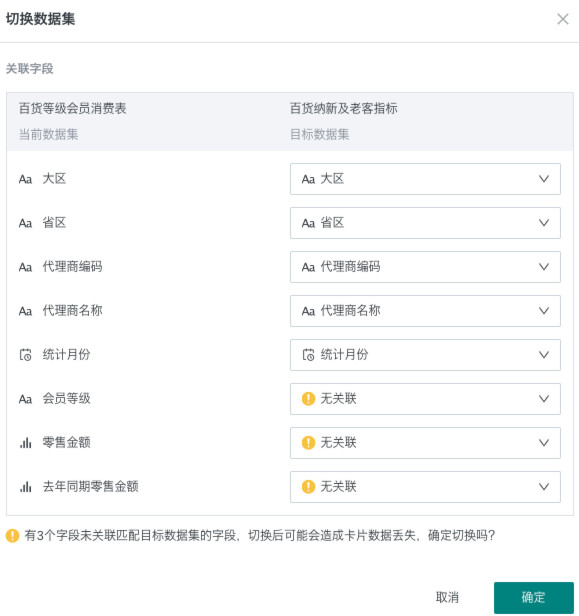 |
| 5 | Click the button to delete the associated dataset. The delete operation will require secondary confirmation to prevent accidental deletion. |
3.3.4. Error Set
Prioritize maintaining the business knowledge base. For questions that are difficult to clearly maintain in the business knowledge base, you can add the questions to the error set.
Please do not add overly simple or non-long-term effective questions to the error set.
3.3.4.1. Create Error Set
Supports batch import and individual creation.
- Individual Creation: Click "New" to jump to the "New Error Set" interface, enter the question description and corresponding SQL statement in this interface, click "OK" to add this question to the error set after "Preview" validation is completed.
The system will check the current SQL syntax type and provide prompts (extracted dataset syntax type is displayed as Spark). If there are mixed SQL scenarios with different direct connection datasets, an error will be prompted that cross-database queries are currently not supported.

- Batch Import: Click "Download Question List Sample" to download the template to local, fill in according to the template and click "+" to upload. SQL validation will automatically start after upload.
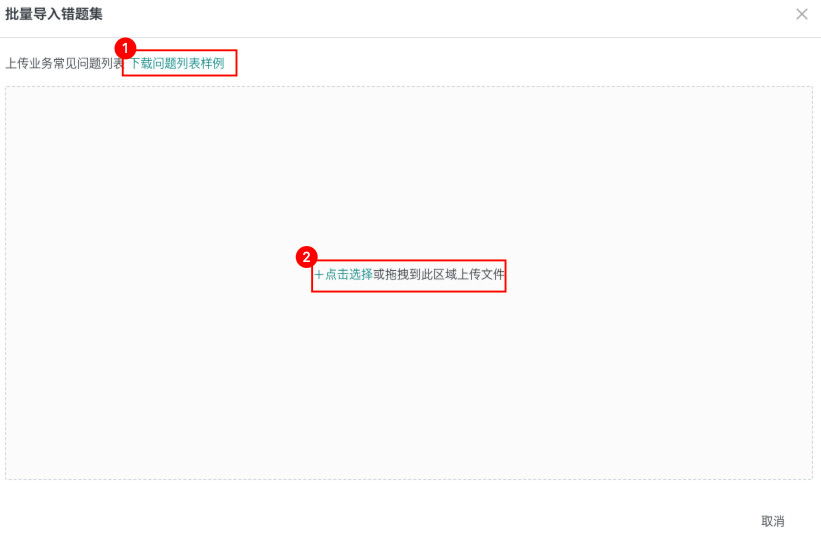
3.3.4.2. Set as Recommended Question
If the "Set as Recommended Question" switch is turned on, this question can be displayed in Recommended Questions.

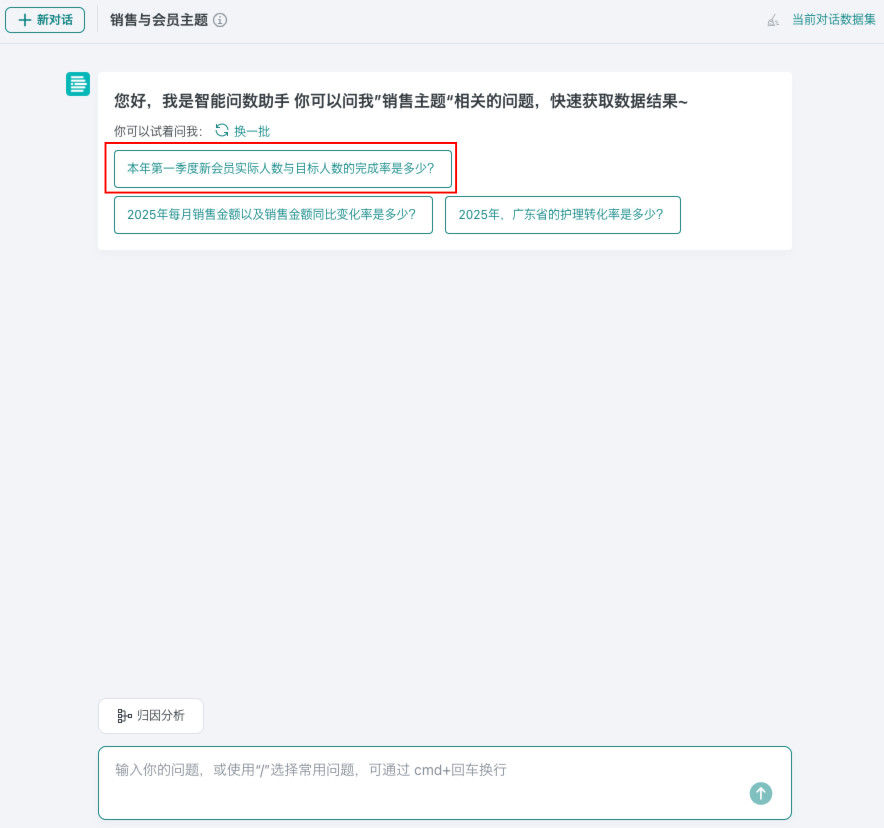
3.3.4.3. Edit Error Set
Click the edit button on the right to modify existing error sets.

The system will check the current SQL syntax type and provide prompts (extracted dataset syntax type is displayed as Spark). If there are mixed SQL scenarios with different direct connection datasets, an error will be prompted that cross-database queries are currently not supported.

3.3.4.4. Delete Error Set
Click this button to delete the error set. The delete operation will require secondary confirmation to prevent accidental deletion.

3.3.4.5. Batch Import/Export
When existing error sets need batch modification or addition, you can export Excel through "Batch Export", modify and add in Excel, then upload Excel through "Batch Import" after completion.
During upload, the system will validate the ID. When the ID is the same, it will overwrite that error set; when the ID is different, it will add a new error set.

3.3.5. Business Knowledge Base
The business knowledge base includes general knowledge and business knowledge.
- General Knowledge: Knowledge that needs to be applied in every conversation.
- Business Knowledge: "Industry terminology", "commonly used business terms", "metric caliber definitions" provided to the large model for learning in text format.
3.3.5.1. General Knowledge
Click "Edit" on the right to input general knowledge, which will be referenced in every question.

3.3.5.2. Business Knowledge
In the business knowledge base, the list supports displaying operation records, including the most recent update time and the most recent operator.
- Most Recent Update Time: The time of the most recent edit of this knowledge record, format yyyy-mm-dd hh:mm:ss
- Most Recent Operator: User information of the most recent edit of this knowledge

3.3.5.2.1. Create Knowledge
-
New Business Knowledge: Click "New" to input knowledge description.
-
Batch Import: Click "Download Knowledge List Sample" to download the template to local, fill in according to the template and click "+" to upload. ID validation will automatically start after upload. When the ID is the same, it will overwrite the original knowledge; when the ID is different, it will add a new knowledge.
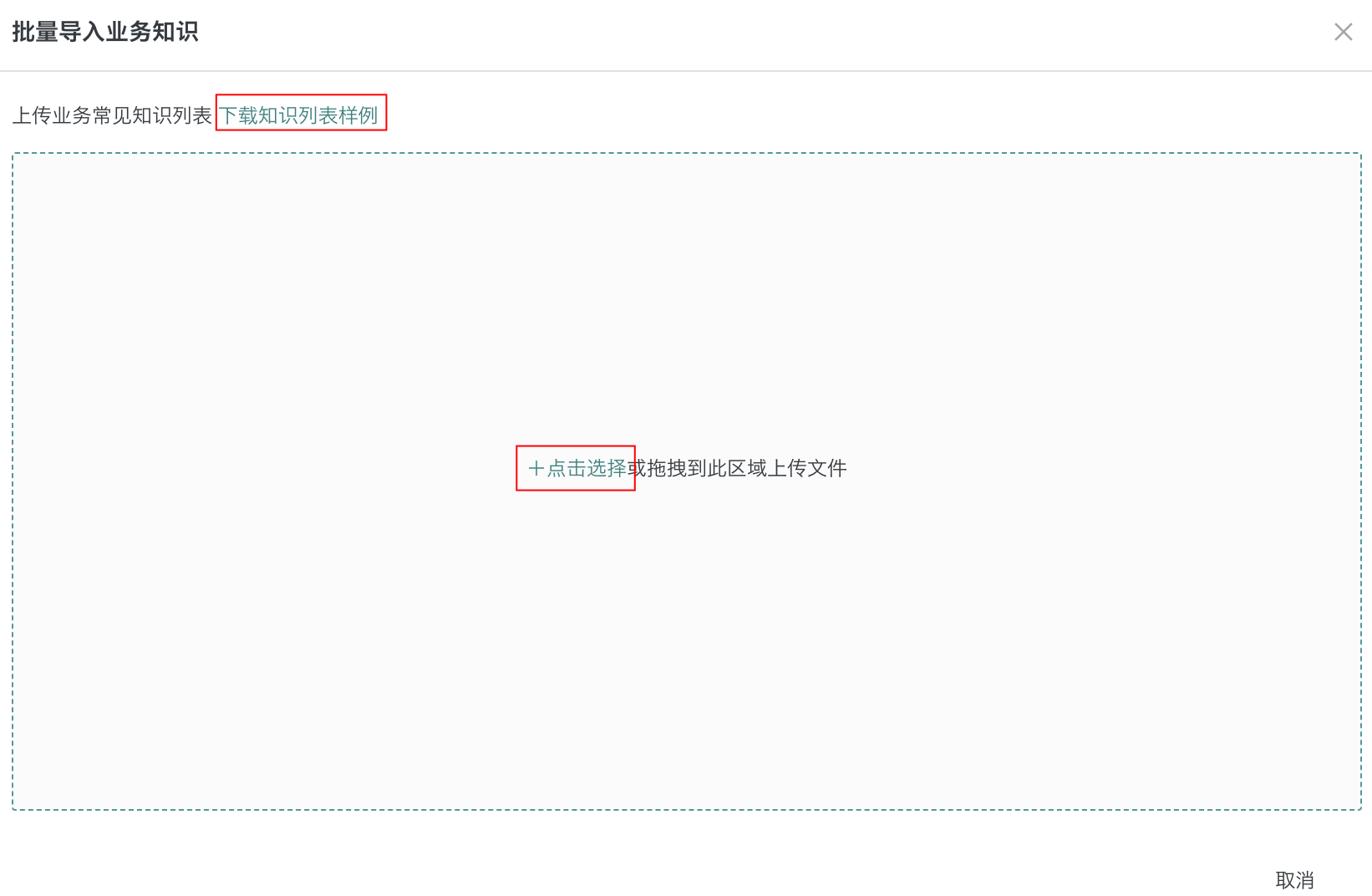
-
Generate Business Knowledge: Click "Generate Business Knowledge", you can select a dashboard to define the business knowledge scope. The dashboard selection range is dashboards that contain cards created with datasets within the current topic.
After selecting the dashboard and confirming, the system will locate cards created with datasets within the current topic based on the current dashboard scope, extract calculation rules for calculated fields, grouped fields, and filtered fields on the cards, and generate business knowledge stored in the business knowledge base.Note: If there are two field formulas with completely identical extraction, the system will perform default deduplication.
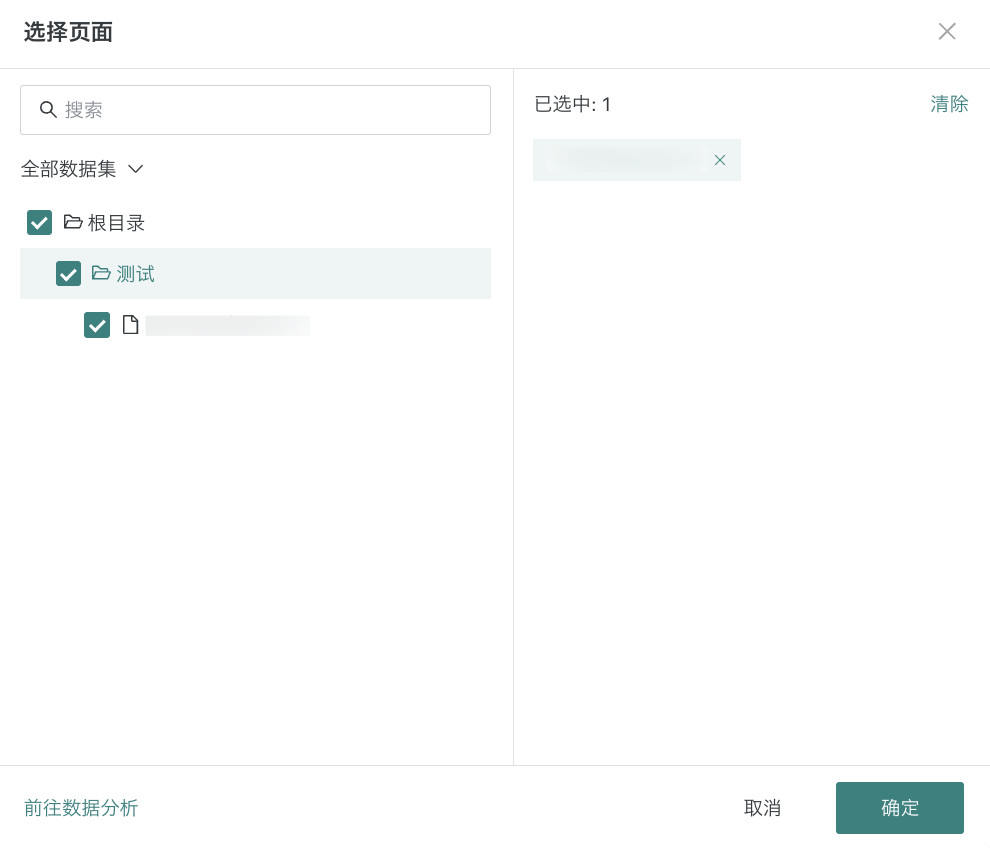
3.3.5.2.2. Edit Knowledge
Click the edit button on the right to modify existing business knowledge.

3.3.5.2.3. Delete Knowledge
Click this button to delete the business knowledge. The delete operation will require secondary confirmation to prevent accidental deletion.

3.3.5.2.4. Batch Import/Export
When existing business knowledge needs batch modification or addition, you can export Excel through "Batch Export", modify and add in Excel, then upload Excel through "Batch Import" after completion.
During upload, the system will validate the ID. When the ID is the same, it will overwrite that knowledge; when the ID is different, it will add a new knowledge.

3.3.6. Permission Management
3.3.6.1. Prerequisites
Edit and authorization permissions have been configured in the BI management backend. Refer to Permission Configuration.
3.3.6.2. Usage Guide
Click "Add User" below, select usage permissions and users to add, then click "Add".
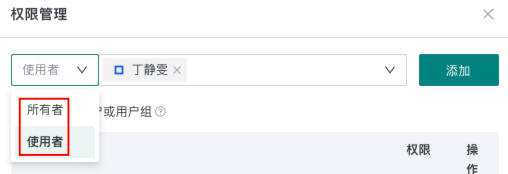
- Owner Permissions: This user can see the current topic in the operations management backend and modify topic name, basic configuration, knowledge base configuration, and permission configuration; at the same time, the user can ask questions about this topic in the frontend.
- User Permissions: This user can ask questions about this topic in the frontend.
3.3.7. Topic Functions
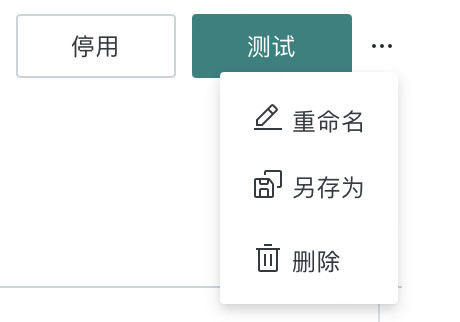
3.3.7.1. Enable/Disable
For topics that are created and tested for the first time, you need to click "Enable" to launch the topic. Business users can see all enabled topics with permissions in the frontend query interface.
If the topic needs to be taken offline, click "Disable" to take the current topic offline. Disabled topics will show "Disabled" status in the left interface. If you want to enable the topic again, click "Enable".
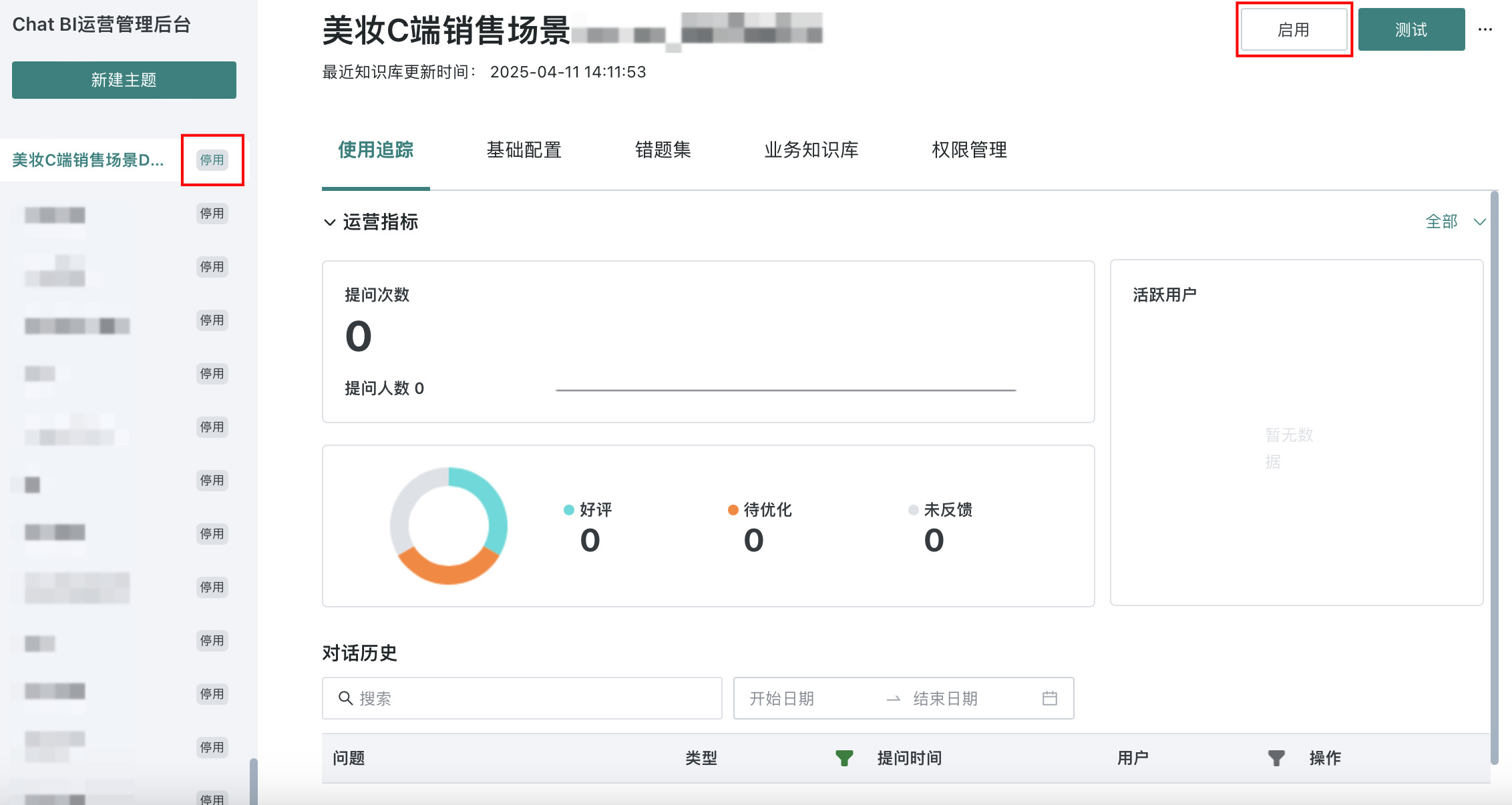
3.3.7.2. Test
-
Click the "Test" button in the upper right corner to enter the test interface.
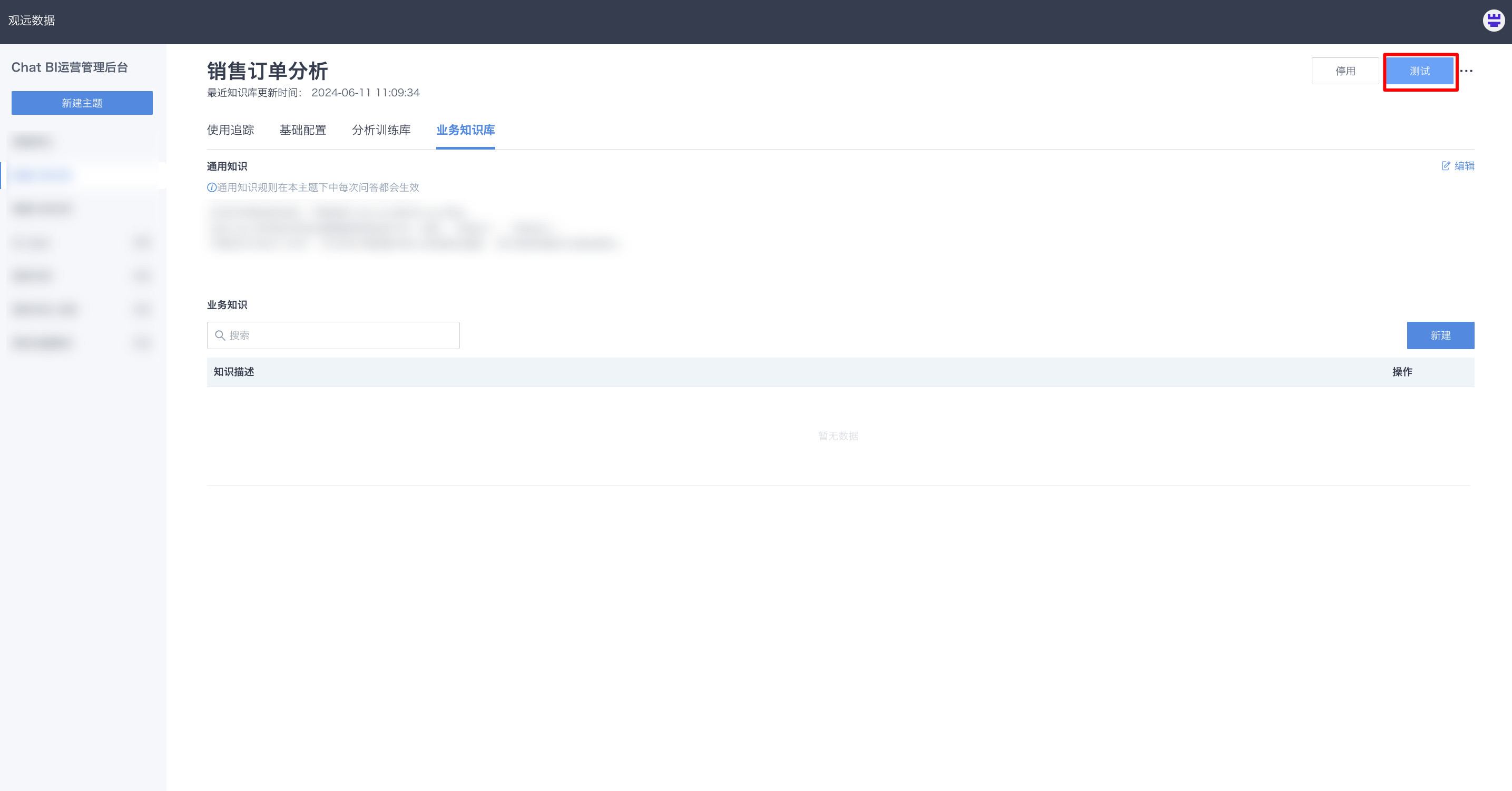
-
In the test interface, add questions by batch importing questions or adding individual questions.
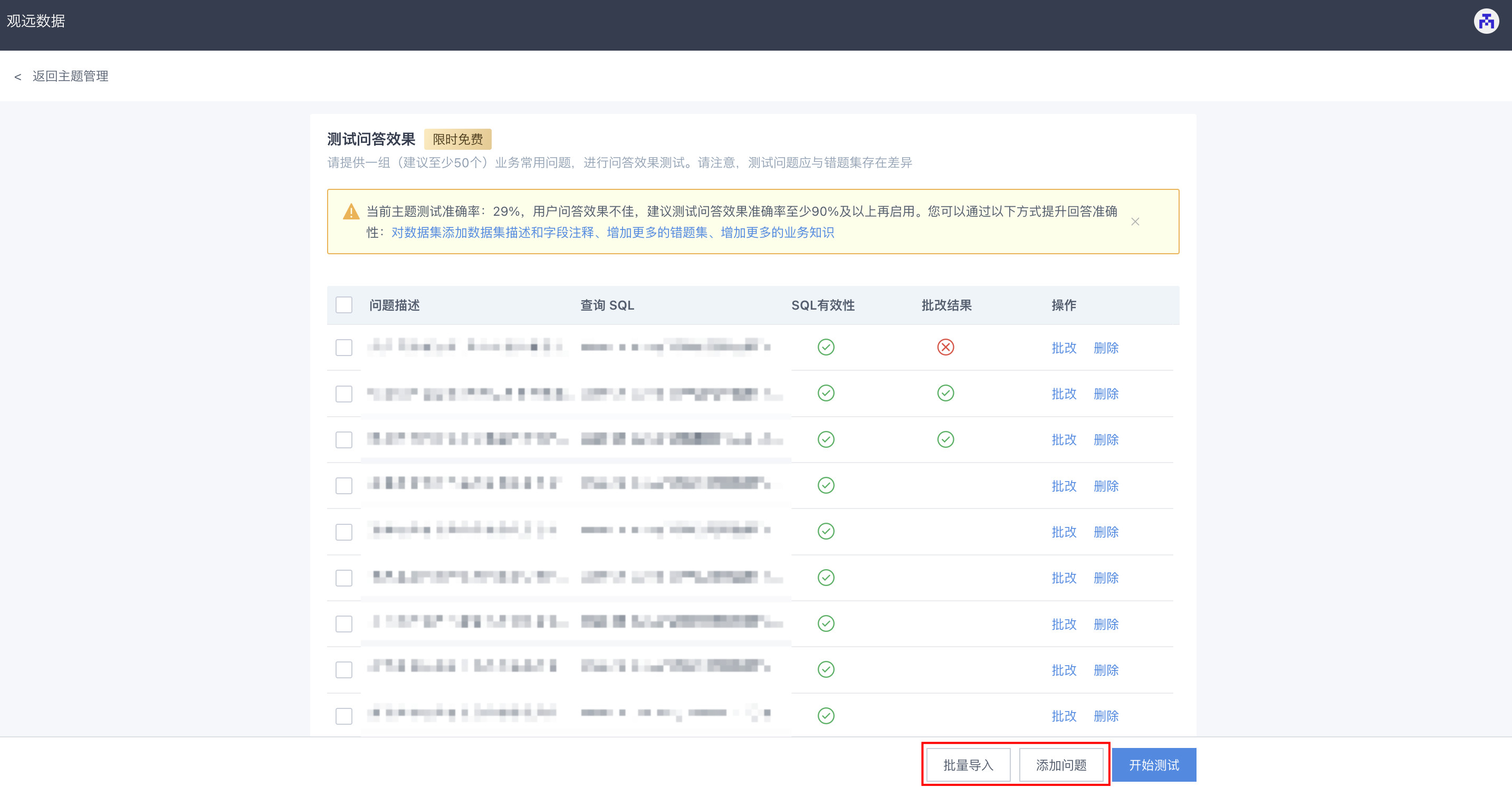
-
Batch Import: For batch import, download the Excel template, fill in the user questions and answer SQL collected from research, and perform batch upload.
NoteThe answer SQL in the question list sample is not required, you can only upload test questions. After uploading the file, testing of all question entries in the file will begin.
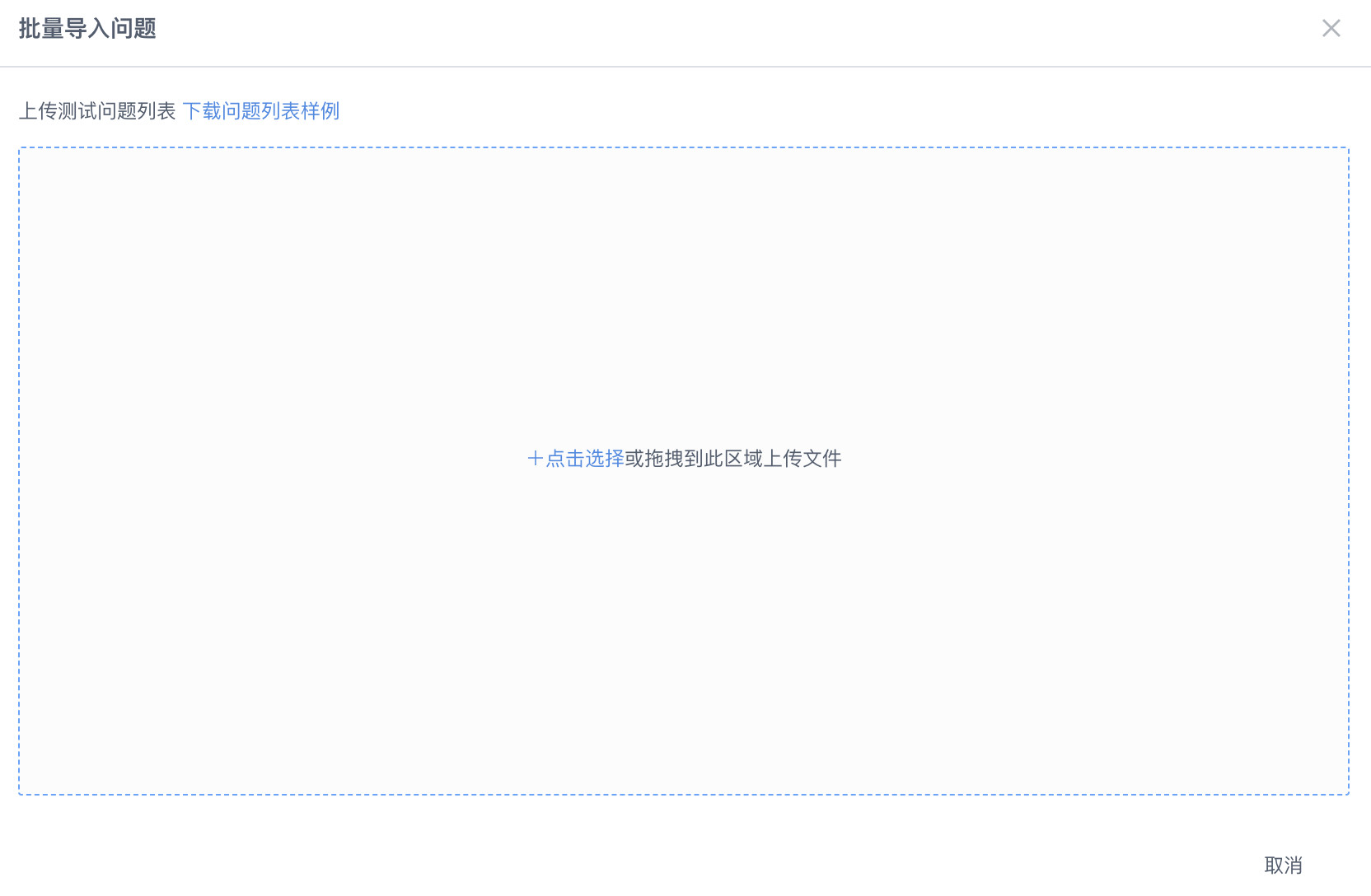
-
Individual Addition: Enter questions and answer SQL one by one, click "OK" to start testing the added question entries.
NoteAnswer SQL is not required, you can only fill in the question description.
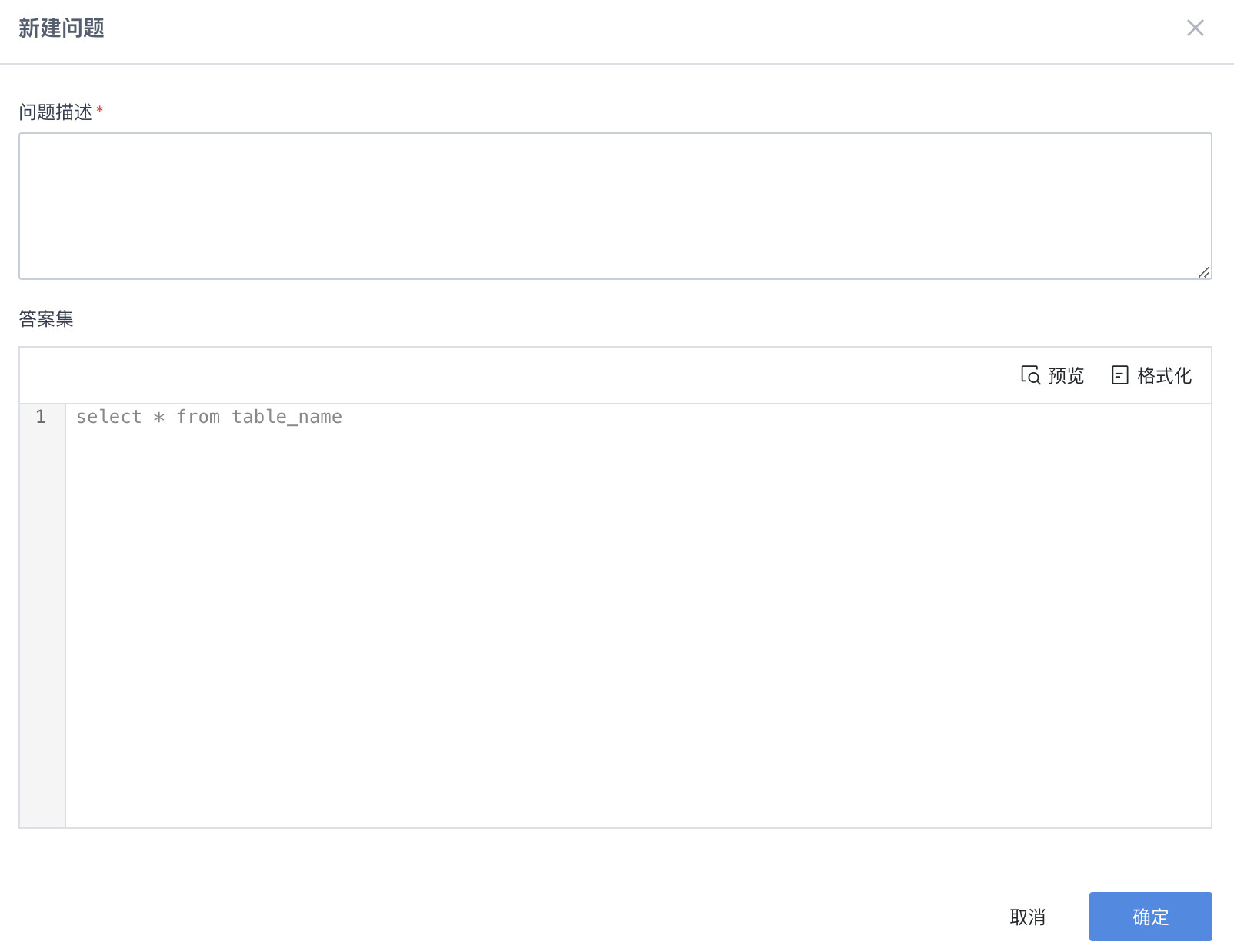
-
-
When triggering question testing, the large model will batch generate SQL results for the current questions based on the current data tables and knowledge. The system executes the SQL to check its validity. If SQL execution fails, the interface will prompt SQL validity and correction result errors.

- At this time, users can click "Correct" to see the details of the SQL generated by the current large model.
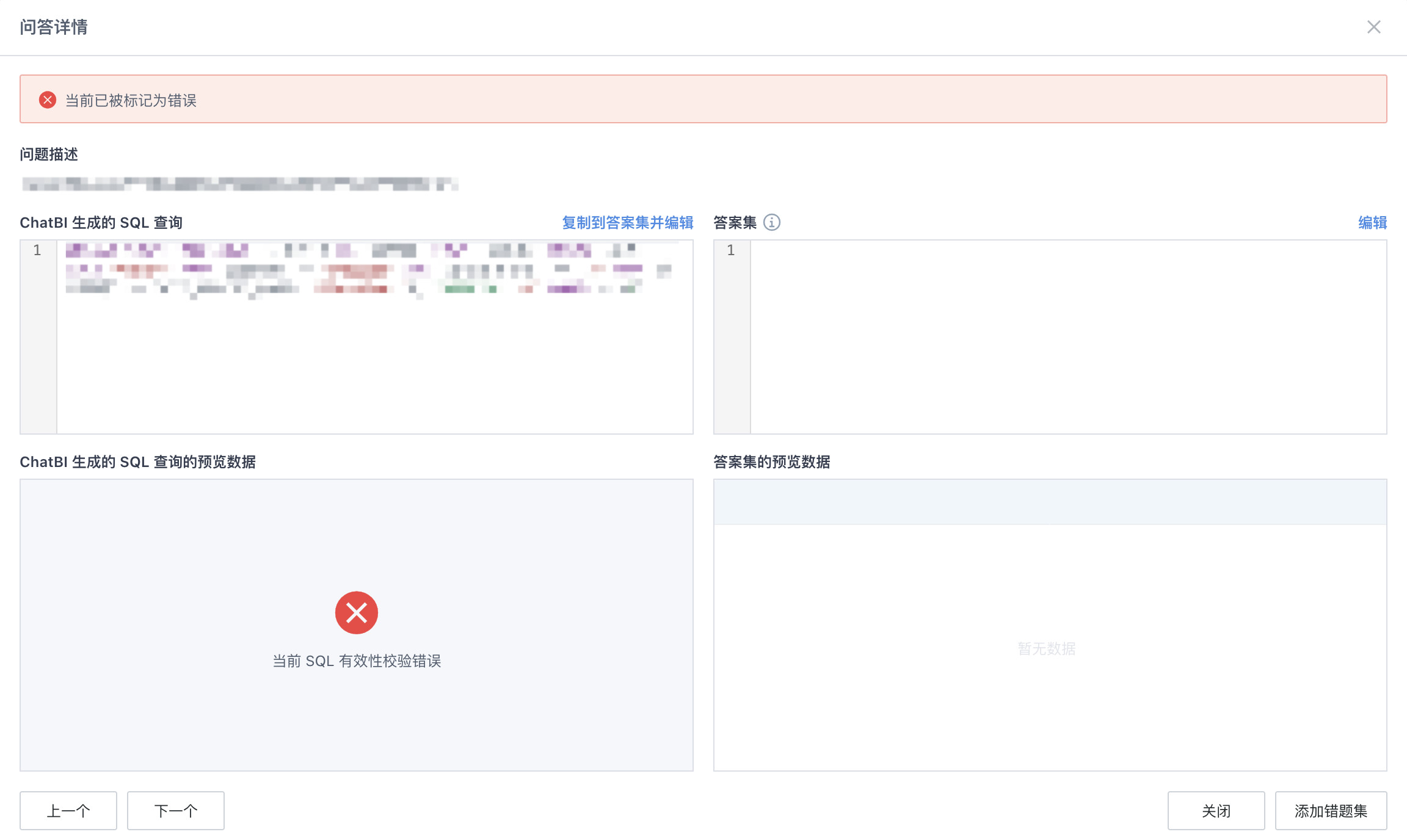
- If there is no answer set at this time, it's recommended that users click "Copy to Answer Set and Edit", correct the SQL and save it. At this time, this question will store a correct SQL as an answer. If there is already an answer set or correct SQL has been maintained in the answer set, click "Add to Error Set" to add this question to the knowledge base.
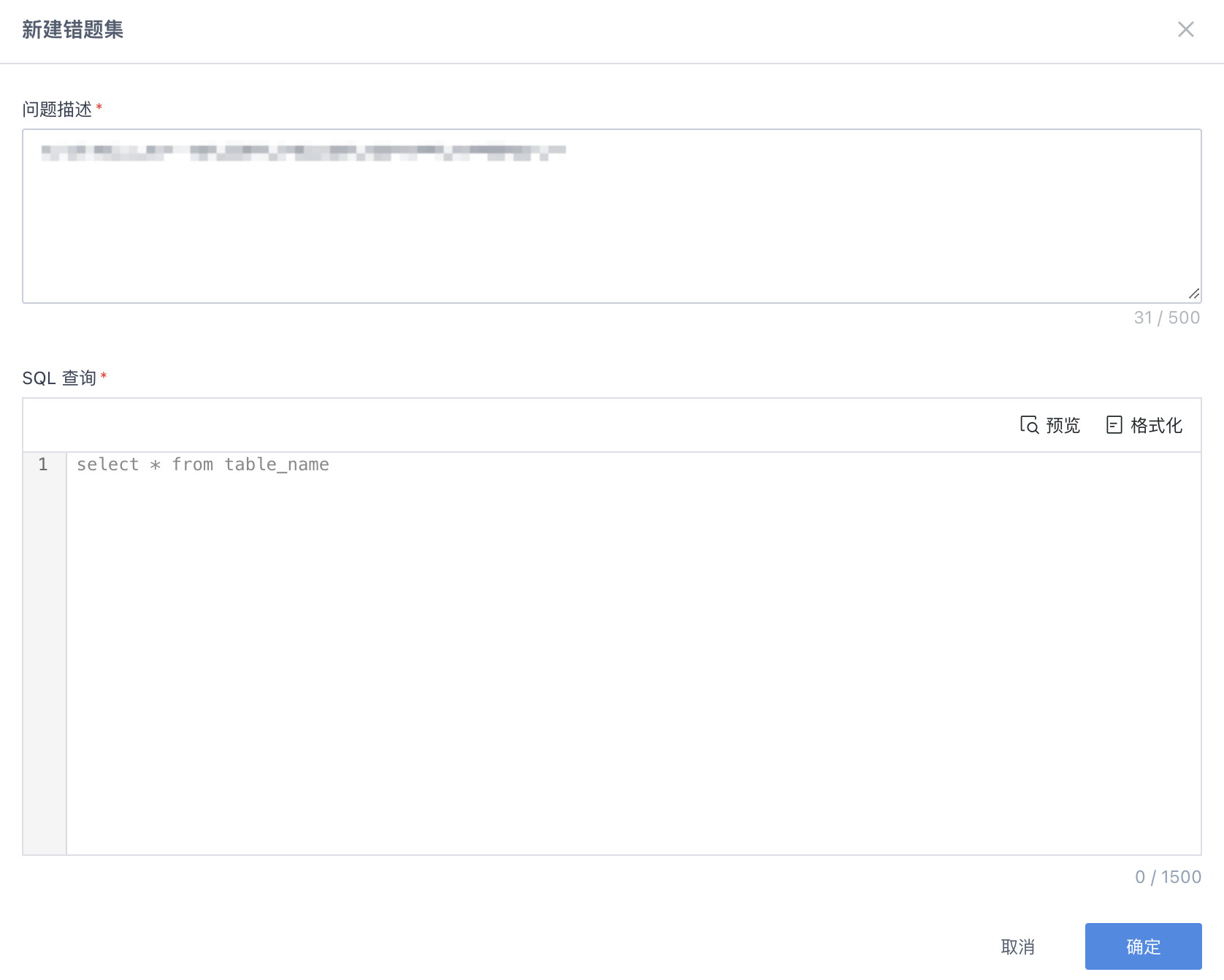
- Finally, return to the list page and check this question for retesting.
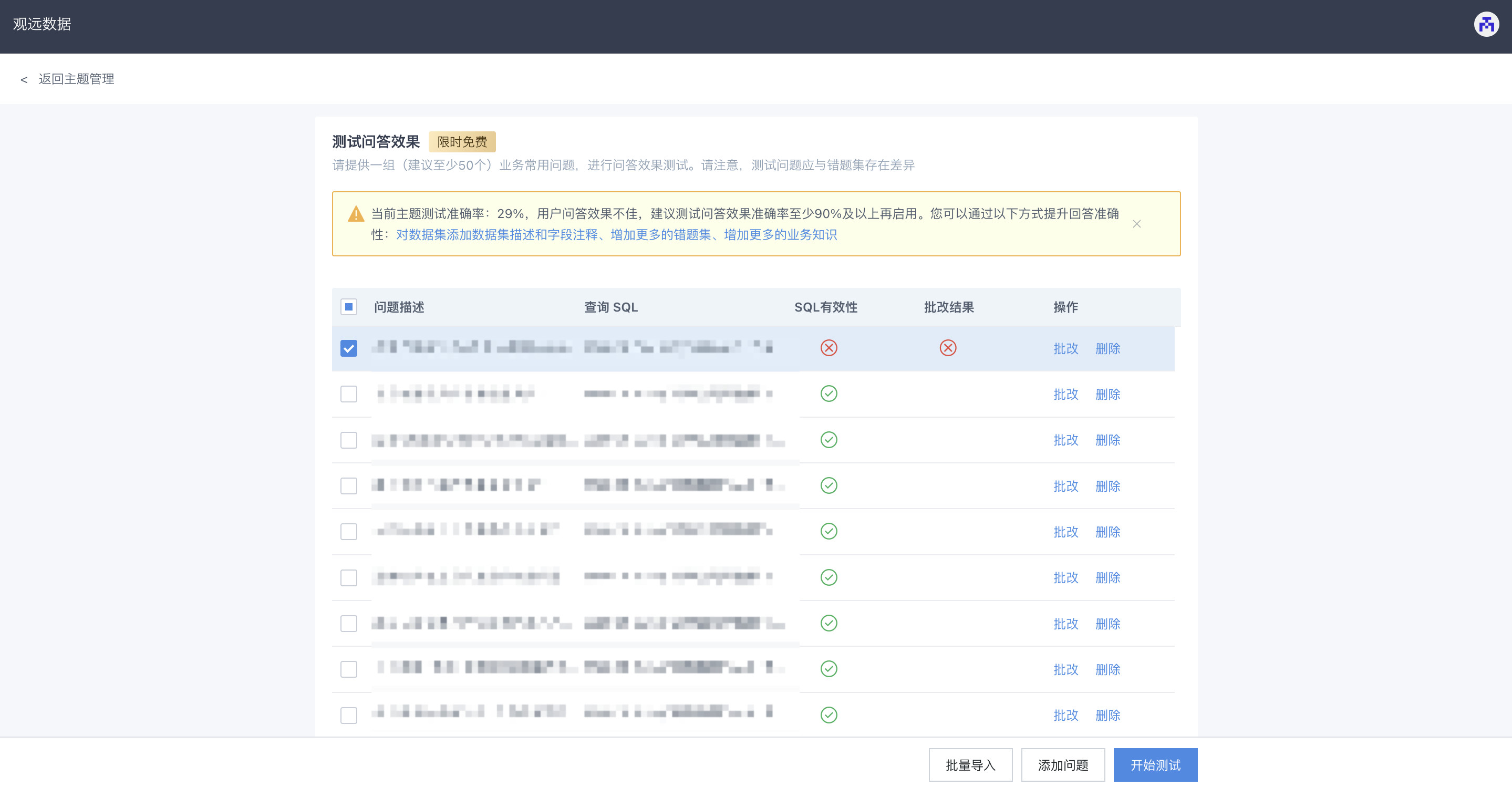
- At this time, users can click "Correct" to see the details of the SQL generated by the current large model.
-
For questions without answer sets, after SQL validity is correct, manual correction is required.
- If the data result is correct, click "Mark as Correct", this test question is judged correct, and the SQL generated by the large model will be automatically entered into the answer set.
- If the data result is wrong, refer to the process in step 3, first maintain the answer set, then click "Mark as Error and Add to Error Set" for knowledge entry maintenance.
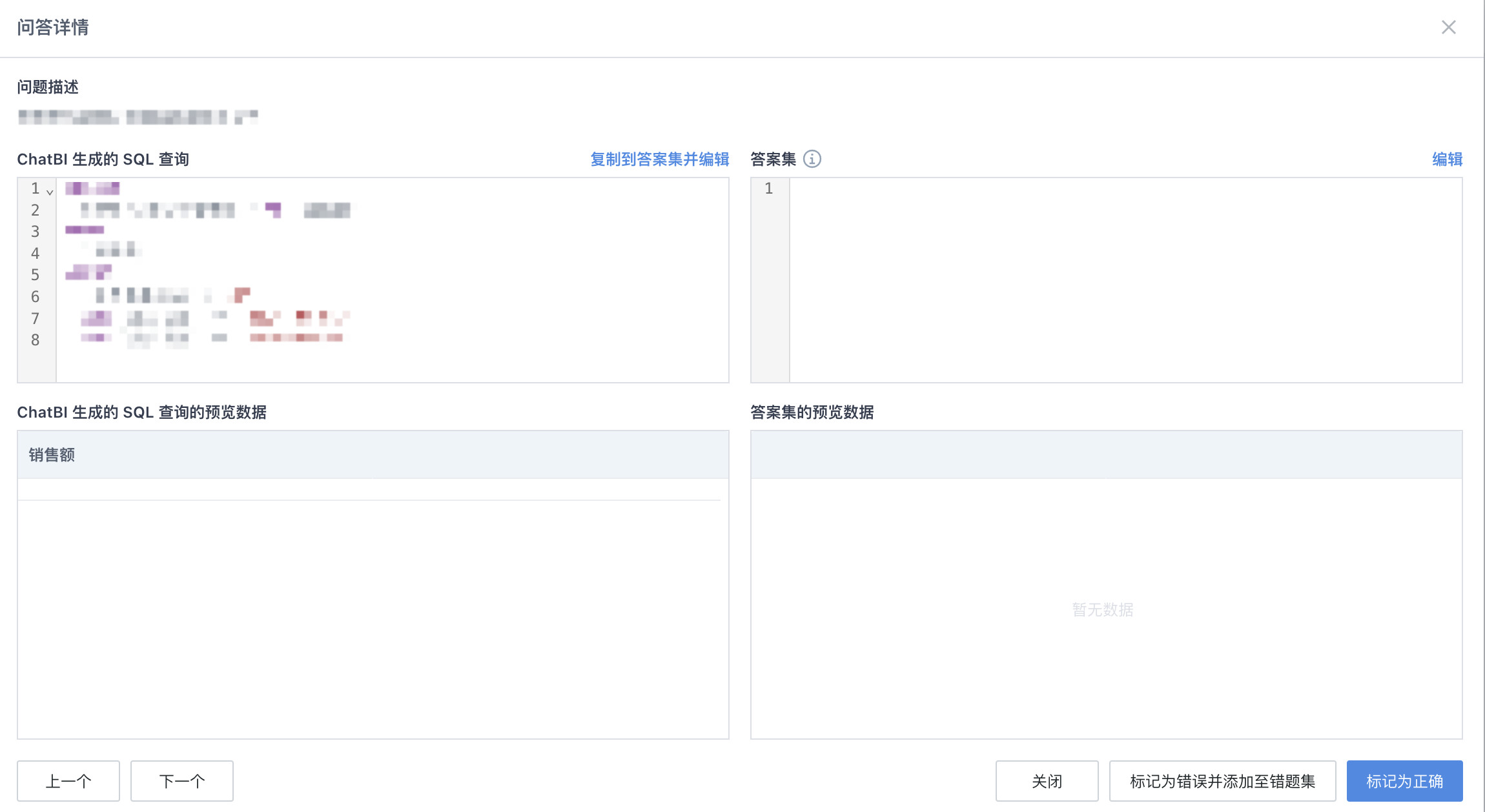
-
For questions with answer sets, the system will compare the execution results of the SQL generated by the large model with the execution results of the answer set SQL. The data must be completely consistent for the system to automatically judge the correction result as correct; if the data is inconsistent, the system correction result is wrong.
- For questions judged correct by the system, you can manually verify the data again to evaluate whether to modify the judgment result.
- For questions judged wrong by the system, refer to the process in step 3, click "Mark as Error and Add to Error Set" for knowledge entry maintenance.
-
After all test questions are corrected, a test accuracy prompt will be generated.
 Note
NoteIt's recommended to put into production only after the topic test accuracy reaches 90% or above.
3.3.7.3. Rename
Click "Rename" to rename the current topic name.
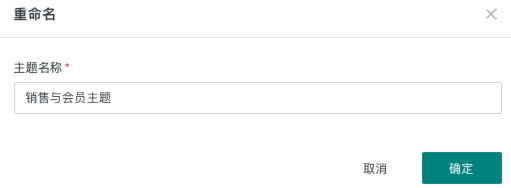
3.3.7.4. Save As
Click "Save As" to quickly create a new topic based on the current topic configuration.
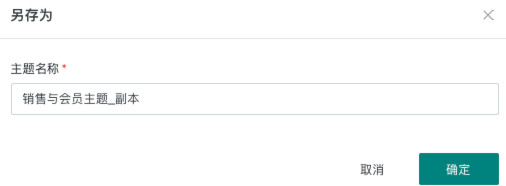
3.3.7.5. Delete
Click "Delete" to delete the current topic. The delete operation will require secondary confirmation to prevent accidental deletion.
